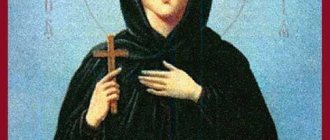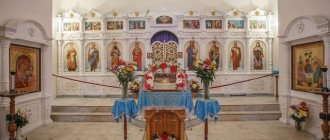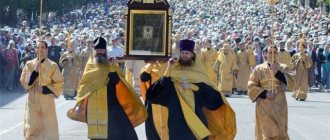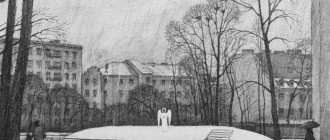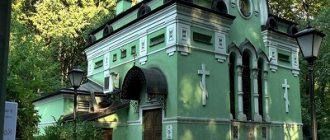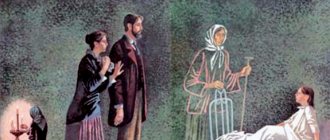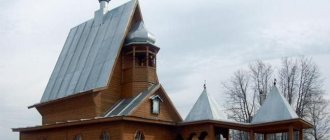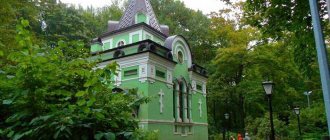Ksenia Alexandrovna Chernega
| Date of Birth | May 1, 1971 |
| Place of Birth | Moscow |
| Citizenship | Russia |
Abbess Ksenia
(in the world
Oksana Aleksandrovna Chernega
(born May 1, 1971 in Moscow) is a lawyer of the Russian Orthodox Church. She participated in the development of laws “On the transfer of religious property to religious organizations”, “Fundamentals of religious cultures and secular ethics” and “On the protection of the feelings of believers” [ 1].
[edit] Biography
Restitution is restoration of property.
Broadcast with the participation of Abbess Ksenia (Chernega), 2012 Born on May 1, 1971 in Moscow. Ksenia is a church name taken after tonsure. Most sources indicate the name Oksana, but according to the Kommersant publication, Chernega bore the name Ksenia from birth[1]. (Actually, Ksenia and Oksana are the same name, it’s just that Ksenia is its church name, and Oksana is its folk form).
In 1993 she graduated from Moscow State Law University with a degree in jurisprudence. In 1998, she graduated from graduate school there and defended her PhD thesis on the topic “Legal model of charity and charitable organizations: civil law and sociological aspects”[2].
From 1993 to 1997, she worked as a lawyer for the religious organization “Legal Service.” In 1997-1998 she taught at the Institute for the Protection of Entrepreneurs. In 1998-2003 she taught at the Moscow State University of Law. Since 2001, she taught the Legal Fundamentals of Parish Operations at the Moscow Theological Academy[3]. In 2003-2010 she taught at the Academy of Labor and Social Relations. Since 2010, he has been teaching at the Moscow Academy of Economics and Law and the Moscow Orthodox Institute of St. John the Theologian[2].
[edit] Intra-church career
In 2004, she was invited by Patriarch of Moscow and All Rus' Alexy II to the position of legal adviser of the Moscow Patriarchate[4].
On August 26, 2009, Patriarch Kirill tonsured the ryasophore (monasticism) with the name Ksenia in honor of the holy blessed princess Ksenia of Tverskaya, and at the same time appointed him as the elder sister of the monastic community at the parish of the Church of All Saints of the former Novo-Alekseevsky Monastery in Moscow[4].
In 2010, in connection with the creation of legal services of the Moscow Patriarchate and the Synodal Department for Relations between the Church and Society, Patriarch Kirill appointed the icon Ksenia as the head of the newly created legal services[4].
On July 16, 2013, by decision of the Holy Synod of the Russian Orthodox Church, she was appointed abbess of the Alekseevsky Convent in Moscow, revived by the same decision. On December 23, 2013, she was tonsured into the mantle by Patriarch Kirill. On March 30, 2014, Patriarch Kirill, during his visit to this monastery, elevated her to the rank of abbess with the laying of a pectoral cross and presentation of the abbot’s staff[5]
Related materials
00:12 — February 24, 2017
“The religiosity of our society is greatly overrated”
Why the transfer of St. Isaac's Cathedral to the Russian Orthodox Church became a problem for the church and society
Mother Ksenia actively participated in the Duma meetings at which the new law was born. “Criminal liability for insulting religious feelings is necessary,” she insisted. “It is necessary to introduce an independent separate article in the Criminal Code, providing for criminal liability for insulting religious feelings.”
The bill was signed by deputies of all four factions of the State Duma, and now with the help of this article they threaten theater directors and artists and judge atheists who dared to write on their blog: “There is no God.”
Mother Ksenia was also a member of the working group for the development of the law “On Education in the Russian Federation” adopted at the end of 2012. Communist deputy Oleg Smolin during the group meetings insisted on excluding from the bill everything that related to the interaction of religious organizations and public schools.
“Some deputies seriously argued that in Russia the public school is “supposedly separated from the church” and therefore the study of the fundamentals of religious culture in Russian schools is unacceptable,” Mother Ksenia was indignant then. “However, the principle of separation of school and church is long and irrevocably a thing of the past.” As a result, Smolin was not heard, the law was adopted exactly as the Russian Orthodox Church wanted, and became the starting point for further attempts to clericalize Russian education, and therefore, in the future, the entire society. Already at the end of 2016, the media wrote about the possible introduction of a compulsory school subject “Orthodox culture”.
[edit] Views and influence
She became interested in Orthodoxy while studying at the university; before that, in her own words, “she was indifferent to religion”[6].
He is distinguished by his extreme intransigence and rigidity of position[1][7]. She took part in the development of laws “On the transfer of property for religious purposes to religious organizations”, “Fundamentals of religious cultures and secular ethics” and “On the protection of the feelings of believers”, defending the most stringent formulations[1]. As the head of the legal service, he represents the interests of the Russian Orthodox Church when considering cases in court, but takes part only in the most complex cases[7].
In a number of cases, Chernega demanded that the church be given not only buildings that previously belonged to the church, but also those that, in Chernega’s opinion, “formed a single complex with them,” even if they never belonged to the church and were not used for religious purposes. For example, in 2012, Chernega demanded that the clinic at Children's Infectious Diseases Hospital No. 12 be transferred to the ownership of the Russian Orthodox Church. Previously, on the site of this clinic there was a temple and an almshouse for the poor, built by Princess Cherkasskaya. During the Soviet era, the buildings were combined to create a clinic. Neither the temple nor the almshouse belonged to the church (they were at the disposal of the Imperial Humane Society) and were not financed by it (the princess built them with her own money and on her own lands). Chernega then stated the following: “It doesn’t matter how much money they were built with, it doesn’t matter who they belonged to before the revolution: the church, the state or private owners... The temple building should definitely be transferred to the Orthodox Church, definitely it [the clinic] should be evicted”[7] [8]. As a result, the clinic was transferred to the ownership of the Russian Orthodox Church, after which a plastic surgery clinic was opened there[9].
In November 2015, on the eve of the demolition day of illegally erected buildings in Moscow (“the night of the long buckets”), Chernega managed to achieve an amendment to Article 222 of the Civil Code of the Russian Federation (“Unauthorized construction”), which excluded religious buildings from the list of unauthorized buildings that could be demolished by the authorities. Thanks to this, a number of chapels built without the necessary paperwork were not demolished[7].
In 2021, she was awarded the medal of the Order of the Holy Equal-to-the-Apostles Princess Olga[2].
Related materials
00:04 — January 28, 2017
God gave - God took
What kind of real estate does the Russian Orthodox Church claim
? “The so-called Ataman Palace was built for the Efremovs to live in; the kitchen was used to prepare food for this family. But we are requesting these objects on the basis that these buildings form a single monastery complex, both historically and documented. And we insist on the transfer of these buildings,” said Mother. Like this. And it seems to no longer matter for what purposes and for whom these buildings were built. They will simply look very good in a single monastery complex.
A story that can outshine in its absurdity not only the Ataman Palace, but several Chersonesos at once, is now unfolding in Moscow on Upper Krasnoselskaya Street. The church is challenging the state's ownership of the buildings of the All-Russian Research Institute of Fisheries and Oceanography (VNIRO). The fact is that the institute ended up on the territory of the Alekseevsky Convent, restored in 2013. And it so happened that Mother Ksenia has been leading the monastery since its revival. By the way, the position of mother in the church hierarchy can be judged by the fact that the highest hierarchs of the Russian Orthodox Church, led by Patriarch Kirill, participated in the ceremony of her elevation to the rank of abbess of the monastery.
All-Russian Research Institute of Fisheries and Oceanography
Photo: Victor P. Romanov / Wikimedia
During the Stalin years, the Alekseevsky Monastery was liquidated, the Holy Cross Church was demolished, and the site, along with its ruins - the foundation and fragments of brickwork on the first floor - was given for construction to the Institute of Fisheries. Now there is a scientific complex of several five-story buildings with a total area of about eight thousand square meters. And over the years, the Third Transport Ring passed through there, a large shopping complex and business-class residential buildings were built. It’s not easy for even Ksenia Chernega to compete with these owners, but with representatives of the scientific community, matters, as a rule, are resolved quickly.
However, the scientists, and with them Rosrybolovstvo and Rosimushchestvo, refused to meekly leave. And, despite two lost trials, they are preparing for the third, which will take place after March 20. This turn, and perhaps the resonant story with Isaac’s transfer, forced Mother Ksenia to move from the genre of laconic legal commentary to a more extensive and detailed description of what was happening within the walls of the institute.
“There is a suspicious silence in the corridors of the institute,” Mother reports, hinting at the lack of scientific activity, “the lower floors are rented out to grocery stores and repair shops, and the ancient tomb of the abbess has been barbarically turned into a crab pool.”
In a conversation with a Lenta.ru correspondent, VNIRO press secretary Anastasia Balyakina said that her mother’s words surprised her. She recalled that scientific institutes also differ from educational institutes in that their corridors and other rooms are usually quiet.
The information that the basement was previously a temple tomb, according to a representative of the institute, was not documented in the archives, nor was the fact of its “barbaric destruction.” It is possible that these events could have taken place in the late 1980s, when the VNIRO aquaculture complex was created. If this is so, then scientists regret what happened.
As for specific developments, in 2015 a program for the conservation of sturgeon in the Caspian Sea was launched, and in March 2017 the institute reported on the results of annual monitoring of aquatic biological resources throughout the country.
Photo: Vadim Zhernov / RIA Novosti
One of the most important tasks today is the determination of total allowable catches (TAC) for fishers and fishing industry enterprises. VNIRO employees approve the ODU annually. If fishermen start harvesting fish without taking into account the TAC recommendations, this could lead to dire environmental and economic consequences. For example, to the extinction of fish in certain fishing areas. And all this against the backdrop of a food embargo, when certain types of fish (primarily salmon) have risen in price by almost 4 times. In 2015 alone, according to Rosstat, the cost of fish products increased by 24 percent on average.
“The institute has a molecular genetics laboratory, one of the few in Moscow and the country, with expensive equipment and a large volume of expert work,” the press service of Rosrybolovstvo, to which the institute is subordinate, explained to Lenta.ru. “Relocating and transporting all scientific equipment to similar premises will require a significant amount from the state budget - at least 3 billion rubles, while the most complex and expensive equipment will most likely be damaged and possibly lost.”
What awaits the building of the institute on Verkhnyaya Krasnoselskaya if it is transferred to the monastery? According to Mother Ksenia, the first priority is to resume divine services there. The abbess claims that the building still contains areas where temple paintings emerge from under the plaster, which means that the temple already lives a “hidden life” that will certainly become apparent. Apparently, religious services are planned to be held in these premises. In a conversation with a Lenta.ru correspondent, Mother Ksenia refused to discuss how the remaining rooms of the huge modern building would be used. “I have already given all the comments,” she said.
Aquaculture complex VNIRO
Photo: Kubedinov Igor / TASS
Back in 2015, Mother Ksenia complained that the church had to make some compromises during the discussion of the law “On the transfer of state or municipal property to religious organizations for religious purposes.” In particular, representatives of the Russian Orthodox Church did not insist on the restitution of property lost by the church, and the state, as a rule, does not offer a single normal building in large cities, but only dilapidated objects that require expensive restoration. Now, according to Chernega, the time has come to get something better, and the church intends to fight for the necessary objects.
The Church has already received many “better” objects that, like Isaac, belonged to the museum and scientific community: the Ipatiev Monastery in Kostroma, the Novodevichy Monastery in Moscow (still closed to any visitors even during off-duty hours) and the Ryazan Kremlin, which will be completely transferred to the Russian Orthodox Church 2021 - these are 22 former museum objects with an area of more than 11 thousand square meters.
But it is not only museum workers who are opponents of the Russian Orthodox Church in restitution arbitrations. The story of 2012, similar to today’s VNIRO broadcast, is no less well known.
[edit] Sources
- ↑ 1,01,11,21,3 Ksenia Chernega, lawyer of the Russian Orthodox Church, abbess of the Alekseevsky convent
- ↑ 2,02,12,2 Ksenia, abbess (Chernega Oksana Aleksandrovna)
- https://www.e-vestnik.ru/persons/inokinya_kseniya_chernega/
- ↑ 4,04,14,2 https://www.hram-ks.ru/Igum_Ksenija.php
- https://www.patriarchia.ru/db/text/3614762.html
- Church lawyer
- ↑ 7,07,17,27,3 What is known about Abbess Ksenia Chernega, who lays claim to the VNIRO building
- Will the old building of the children's clinic be transferred to the Russian Orthodox Church?
- How the Russian Orthodox Church restores “historical justice”
Notes[ | ]
- ↑ 12
Ksenia, abbess (Chernega Oksana Aleksandrovna) // Patriarchy.ru. - JOURNALS of the meeting of the Holy Synod of July 16, 2013 / Official documents / Patriarchia.ru (Russian). Patriarchy.ru
. Date accessed: September 2, 2021. - His Holiness Patriarch Kirill visited the Alekseevsky Stavropegic Monastery / News / Patriarchia.ru (Russian). Patriarchy.ru
. Date accessed: September 2, 2021. - His Holiness Patriarch Kirill chaired the next meeting of the Supreme Church Council / News / Patriarchy.ru
- His Holiness Patriarch Kirill chaired the next meeting of the Supreme Church Council / News / Patriarchy.ru
- His Holiness Patriarch Kirill chaired the meeting of the Supreme Church Council / News / Patriarchy.ru
- His Holiness Patriarch Kirill chaired the last meeting of the Supreme Church Council of 2021 / News / Patriarchy.ru
- His Holiness Patriarch Kirill chaired the meeting of the Supreme Church Council / News / Patriarchy.ru
- Word of His Holiness Patriarch Kirill at the meeting of the Supreme Church Council on April 17, 2021 / Patriarch / Patriarchy.ru
- The Primate of the Russian Church chaired the next meeting of the Supreme Church Council / News / Patriarchy.ru
- His Holiness Patriarch Kirill chaired the next meeting of the Supreme Church Council / News / Patriarchy.ru
- His Holiness Patriarch Kirill led the work of the next meeting of the Supreme Church Council / News / Patriarchy.ru
- His Holiness Patriarch Kirill chaired the first joint meeting of the Holy Synod and the Supreme Church Council of the Russian Orthodox Church in a century / News / Patriarchy.ru
- JOURNALS of the meeting of the Holy Synod of August 25, 2021 / Official documents / Patriarchia.ru (Russian). Patriarchy.ru
. Date accessed: September 2, 2021. - For the first time, a woman became a member of the Supreme Church Council of the Russian Orthodox Church (unspecified)
.
TASS
(August 25, 2020).

